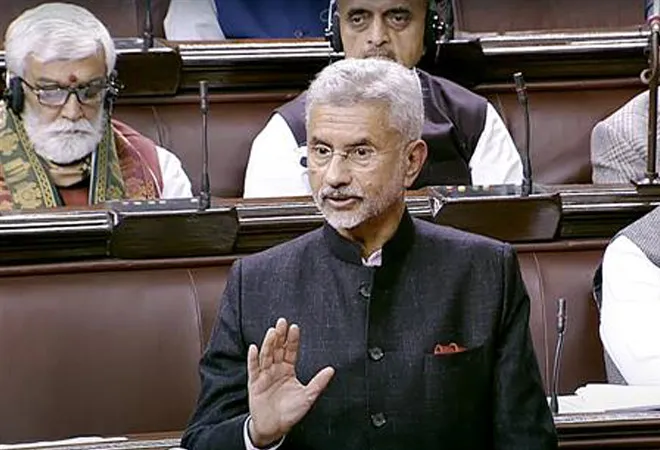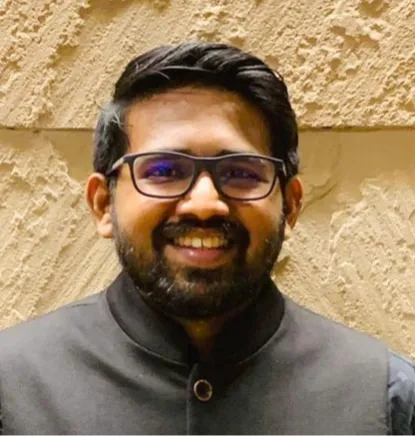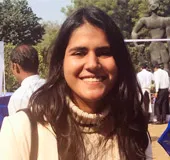-
CENTRES
Progammes & Centres
Location
As India anchors itself as an emerging pole in this multipolar world order, it is crucial to understand the operational requirements of the Ministry of External Affairs

Last month, the Committee on External Affairs released the 20th report on Demands for Grants, which offers several key insights into the Ministry of External Affairs (MEA) and its operationality.
Budgets and Constraints
Despite India’s fast-increasing global footprint and role, the MEA remains one of the least funded central ministries in India. The budget allocated to the Ministry has consistently remained at less than 1 percent of the overall budget. The percentage of overall budget allocation to the MEA has been on the decline since 2019 (see Table 1); this is likely due to a significant increase in the Government of India’s internal expenditures. This year’s budget of INR18,050 crores (0.40 percent) is the second highest allocation in the past five years. An estimated expense of INR 990 crores for India’s G20 presidency has contributed to this increase in overall allocation.
The system of aid allocation in the Ministry is also mired with other challenges. The disparity in the demand-allocation ratio, the reduction in allocation in the revised estimates, and the difficulty in ensuring equal and rational allocation are some of the major bottlenecks. The pace of expenditure has been slow in some quarters, and final quarters have often witnessed the disbursement of large amounts of funds. Full utilisation of the allocated funds has also been a challenge for the MEA since the onset of COVID-19.
The unspent balance in 2020-21 was 634 crores, and 1828 crores in the following year.
Table 1. Demands, Allocation, and Expenditure of the MEA
| Year | BE Demand | BE Allocation | BE % of budget | RE Demand | RE allocation | RE % of Budget | Actual Expenditure |
| 2020-21 | 20873.40 | 17346.71 | 0.57% | 18256.59 | 15000 | 0.43% | 14365.84 (95.77%) |
| 2021-22 | 22888.73 | 18154.73 | 0.52% | 18224.52 | 16000 | 0.42% | 14173.70 (88%) |
| 2022-23 | 20707.18 | 17250 | 0.44% | 19095.45 | 16972.9 | 0.41% |
10375.9* (94%)** |
| 2023-24 | 21276.65 | 18050 | 0.40% | - | - | - | - |
** Estimate; * Expenditures up to December 2022
Partnerships for Development
Aimed at complementing India’s overall priorities in its neighbourhood and beyond and to counter increasing Chinese presence, Technical and Economic Cooperation (TEC) has been allocated a major chunk of sectoral allocation in the budget, which is worth INR 5848.58 crores. Of this, INR 5080.24 crores is in the form of grants and the remaining INR 768.34 crores are loans. India’s assistance takes many different forms—Lines of Credit (LOCs), Grant assistance, technical consultancy, disaster relief, humanitarian relief, heritage restoration, educational scholarships, capacity-building programmes, etc. The assistance is provided based on the needs of partner countries, India’s interests, and the sustainability of the projects.
While these grants and loans are meant for countries from different regions, including Latin America, Africa, and Southeast Asian nations, etc, the immediate neighbourhood gets a major chunk of these allocations. In recent years, aid in the neighbourhood has focused more on connectivity projects such as railway links, roads and bridges, waterways, border-related infrastructure, power generation, hydropower projects, etc.
Table 2. Assistance to Neighbouring countries
| Country | BE 2022-23 (in crores) | BE 2023-24 (in crores) |
| Bangladesh | 300 | 200 |
| Bhutan | 1560.01 | 1632.24 |
| Nepal | 750 | 550 |
| Sri Lanka | 200 | 150 |
| Myanmar | 600 | 500 |
| Afghanistan | 200 | 200 |
| Maldives | 360 | 400 |
In India’s neighbourhood (refer to Table 2), Bhutan and Maldives have seen an increase in assistance. Bhutan has received the largest bilateral assistance worth INR 2400 crores. This assistance includes both grants (INR 1632 crores) and loans (INR 768 crores). Nepal, Sri Lanka, and Bangladesh have all seen a drop in assistance. For Nepal and Bangladesh, the assistance has dropped as most projects have been completed or are in the final stages of completion. In Sri Lanka, while allocation has declined due to the economic crisis, it is expected to increase this year as many projects are under the tendering stage. Support to Afghanistan and Myanmar has been hindered due to the volatile political-economic and security situations in these countries. However, the utilisation of aid is more than 50 percent in both Afghanistan and Myanmar, as opposed to others where it hovers somewhere between 30-40 percent.
While there is a consensus on the importance of this type of cooperation to advance India’s interests and generate goodwill for the country, the percentage share of development cooperation in the overall budget has consistently fallen, from 42.06 percent to only 32.40 percent in 2023-24. Consistency, efficient utilisation of said aid amount, and the timely completion of projects have also been a challenge for the MEA. Multiple factors affect the budget allocation and the implementation of a particular project—local security conditions of the partner country, the natural environment, and the reciprocity of the host government and their policy priorities. For India, logistical constraints in the other country, different procurement rules, differences in regulatory mechanisms, and the political-economic situation impede the effective completion of projects.
Expanding Diplomatic Presence and Influence
Indian missions and posts abroad have received the second highest sectoral allocation in the budget, with an outlay of INR 3528 crores. With over 201 diplomatic missions and posts, India has been attempting to expand its diplomatic presence and missions in Latin America, the Caribbean, Africa, and Europe. Since 2018, nearly 15 new Indian missions have been operationalised in Africa. In December 2020, new missions were opened in Estonia, Paraguay, and the Dominican Republic. However, despite these initiatives, this budget has seen a decline in the sector by around INR 240 crores. The Ministry also continues to be short-staffed. With the current size of 4488 personnel, out of whom only 1011 personnel are Foreign Service officers, India is the most short-staffed diplomatic service in the world. Slow and limited UPSC and SSC recruitments, along with the Ministry’s slow absorption to avoid stagnation at the top level, continue to challenge India’s diplomatic expansion and efficiency.
Multiple factors affect the budget allocation and the implementation of a particular project—local security conditions of the partner country, the natural environment, and the reciprocity of the host government and their policy priorities.
Special diplomatic expenditure gets the third highest allocation worth INR 4162 crores. This is distantly followed by the allocation of INR 1518 crores for the MEA Secretariat’s administrative expenses. The Passports and emigration section has received the fifth highest allocation worth INR 1002 crores.
As migration and diaspora have received significant attention from the government in recent years, there are increasing efforts to increase the availability and affordability of passports. As of now, 430 Passport Seva offices are operational throughout the country; four new offices will also be opening soon. There are also increasing efforts to digitise passport services and decrease the duration of police verification and passport provision. However, the ministry continues to face challenges with 36 percent of the Central Passport Organisation’s total labour force being vacant. To sensitise migrants to the rules and regulations of host countries, the government has authorised 5 new Protector of Emigrants (PoE) offices and 58 new Pre-Departure Orientation Training (PDOT) centres. This is in addition to pre-existing and pre-operating 14 PoEs and 32 PDOTs.
Considering the significance of the Diaspora for remittances and soft power projection, the Ministry has allocated nearly INR 50 crores for Engagement with the Indian Diaspora and the Welfare of Overseas Indians, i.e., INR 37 crores and INR 13 crores respectively. The government uses the engagements with the diaspora to familiarise them with the rest of India and Indian culture and also build networks with different Indian professional classes, such as scientists, businessmen, army personnel, scientists, students etc. Similarly, the government is invested in PDOT sessions, evacuations, repatriation of Indians; and is providing legal assistance and counselling through its Welfare of Overseas Indians initiative. However, the efficient use of these funds has been an issue. Last year, only INR 0.06 crores were used out of the allocated INR 97 crores for the Welfare of Overseas Indians, and only INR 14 crores were used out of the allocated INR 46 crores for engagement with the Indian diaspora. The diaspora’s hesitancy to engage or register with the embassy has also hindered the efficiency of the missions.
To sensitise migrants to the rules and regulations of host countries, the government has authorised 5 new Protector of Emigrants (PoE) offices and 58 new Pre-Departure Orientation Training (PDOT) centres.
Outreach and collaboration
The formulation of India’s foreign policy, while falling under the remit of the Ministry, is also a collaborative effort influenced by multiple stakeholders—the territorial divisions of a specific country, the think tank community, and academic institutes. This step-by-step policy formulation and MEA’s contribution to knowledge production is sustained through its support to various autonomous bodies and institutes. It funds research organisations and think tanks, apart from holding track 1.5 and 2 dialogues. The pandemic did lead to a fall in funding for these organisations, but with India presiding over the G20 this year, the funding for some institutes has been augmented drastically.
Conclusion
The findings of this report have come at an opportune time for India. As India tries to navigate through the ruptures in the post-COVID world and assumes the leadership of the G20, New Delhi must analyse the bottlenecks and gaps in its budget allocation, functioning and the disbursement of aid in its neighbourhood and beyond.
The views expressed above belong to the author(s). ORF research and analyses now available on Telegram! Click here to access our curated content — blogs, longforms and interviews.

Aditya Gowdara Shivamurthy is an Associate Fellow with the Strategic Studies Programme’s Neighbourhood Studies Initiative. He focuses on strategic and security-related developments in the South Asian ...
Read More +
Shivam Shekhawat is a Junior Fellow with ORF’s Strategic Studies Programme. Her research focuses primarily on India’s neighbourhood- particularly tracking the security, political and economic ...
Read More +